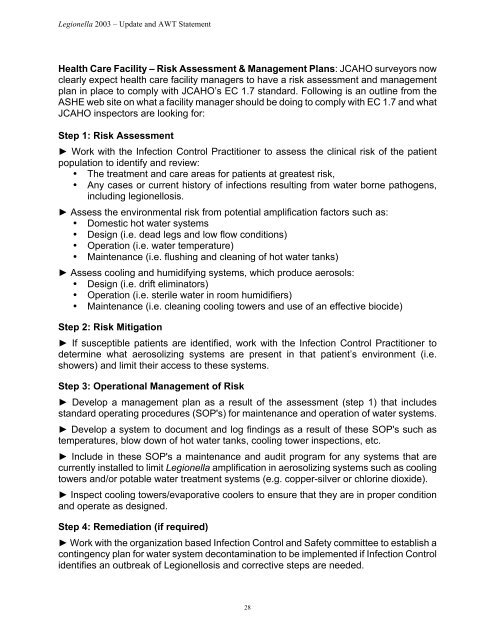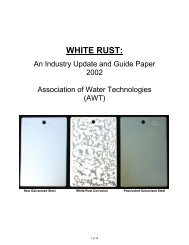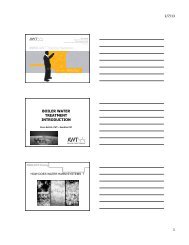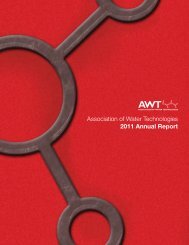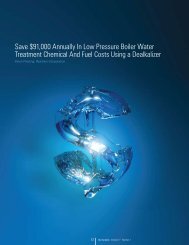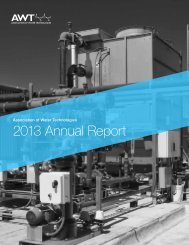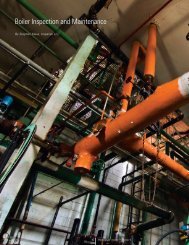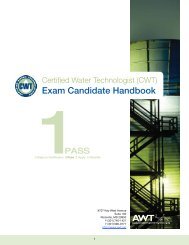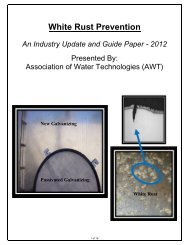Legionella: An Update and Statement by AWT - Association of Water ...
Legionella: An Update and Statement by AWT - Association of Water ...
Legionella: An Update and Statement by AWT - Association of Water ...
You also want an ePaper? Increase the reach of your titles
YUMPU automatically turns print PDFs into web optimized ePapers that Google loves.
<strong>Legionella</strong> 2003 – <strong>Update</strong> <strong>and</strong> <strong>AWT</strong> <strong>Statement</strong><br />
Health Care Facility – Risk Assessment & Management Plans: JCAHO surveyors now<br />
clearly expect health care facility managers to have a risk assessment <strong>and</strong> management<br />
plan in place to comply with JCAHO’s EC 1.7 st<strong>and</strong>ard. Following is an outline from the<br />
ASHE web site on what a facility manager should be doing to comply with EC 1.7 <strong>and</strong> what<br />
JCAHO inspectors are looking for:<br />
Step 1: Risk Assessment<br />
► Work with the Infection Control Practitioner to assess the clinical risk <strong>of</strong> the patient<br />
population to identify <strong>and</strong> review:<br />
• The treatment <strong>and</strong> care areas for patients at greatest risk,<br />
• <strong>An</strong>y cases or current history <strong>of</strong> infections resulting from water borne pathogens,<br />
including legionellosis.<br />
► Assess the environmental risk from potential amplification factors such as:<br />
• Domestic hot water systems<br />
• Design (i.e. dead legs <strong>and</strong> low flow conditions)<br />
• Operation (i.e. water temperature)<br />
• Maintenance (i.e. flushing <strong>and</strong> cleaning <strong>of</strong> hot water tanks)<br />
► Assess cooling <strong>and</strong> humidifying systems, which produce aerosols:<br />
• Design (i.e. drift eliminators)<br />
• Operation (i.e. sterile water in room humidifiers)<br />
• Maintenance (i.e. cleaning cooling towers <strong>and</strong> use <strong>of</strong> an effective biocide)<br />
Step 2: Risk Mitigation<br />
► If susceptible patients are identified, work with the Infection Control Practitioner to<br />
determine what aerosolizing systems are present in that patient’s environment (i.e.<br />
showers) <strong>and</strong> limit their access to these systems.<br />
Step 3: Operational Management <strong>of</strong> Risk<br />
► Develop a management plan as a result <strong>of</strong> the assessment (step 1) that includes<br />
st<strong>and</strong>ard operating procedures (SOP's) for maintenance <strong>and</strong> operation <strong>of</strong> water systems.<br />
► Develop a system to document <strong>and</strong> log findings as a result <strong>of</strong> these SOP's such as<br />
temperatures, blow down <strong>of</strong> hot water tanks, cooling tower inspections, etc.<br />
► Include in these SOP's a maintenance <strong>and</strong> audit program for any systems that are<br />
currently installed to limit <strong>Legionella</strong> amplification in aerosolizing systems such as cooling<br />
towers <strong>and</strong>/or potable water treatment systems (e.g. copper-silver or chlorine dioxide).<br />
► Inspect cooling towers/evaporative coolers to ensure that they are in proper condition<br />
<strong>and</strong> operate as designed.<br />
Step 4: Remediation (if required)<br />
► Work with the organization based Infection Control <strong>and</strong> Safety committee to establish a<br />
contingency plan for water system decontamination to be implemented if Infection Control<br />
identifies an outbreak <strong>of</strong> Legionellosis <strong>and</strong> corrective steps are needed.<br />
28


